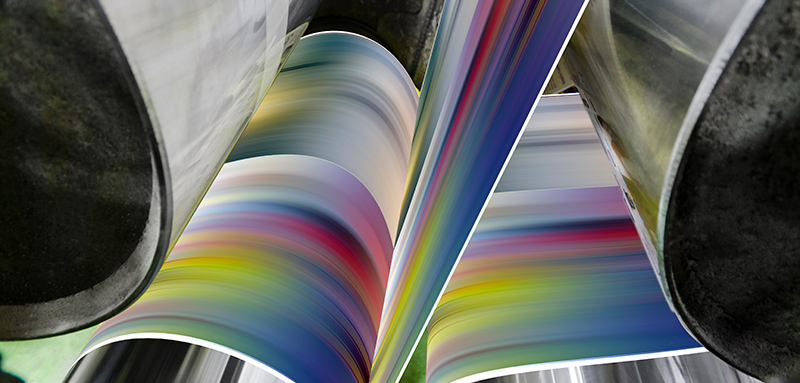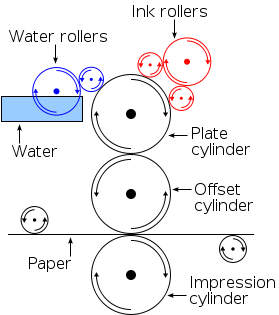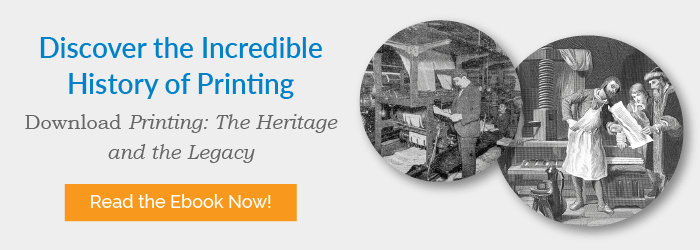
The days of Gutenberg – when printing presses were straightforward, hand-operated devices – are long behind us. In the modern era, the typical commercial printer’s factory floor is populated by sophisticated automated machinery that can churn out high-quality printed products in volumes and at speeds that would turn Gutenberg’s head around.
In this article, we’ll explain one of the oldest and most common commercial printing techniques still used today: offset printing.
Offset printing has been a stalwart of the printing business since the early 21st century. Along with flexographic and digital printing, it remains a go-to technology for custom label printers.
The History of Offset Printing
Offset printing may be best understood in the context of its evolution.
The earliest printing methods (such as Gutenberg’s famed invention) involved transferring ink from raised surfaces onto paper or other material. In the late 18th century, along came lithography. Lithography is a planographic printing technique, meaning the image-carrying surface is flat.
Lithography makes use of the principle that water and oil repel each other. An image is drawn on a flat surface (originally stone, later metal) with a greasy substance, and the remainder of the surface is treated with water. Oil-based ink is then applied. The ink sticks to the greasy areas but washes away from the wet sections, leaving behind an image that can be pressed onto paper.
Over the years, lithography became more mechanized, and by the late 19th century, steam-powered rotary lithographic presses were employed in the U.S. and Europe. These presses used zinc or aluminum lithographic plates that could be bent around a cylinder. The problem was, the images on the plates were quite delicate and wore off quickly after direct contact with the printing surface.
The solution was to transfer the image to an intermediate surface before printing – to offset it.
The first offset printers, which appeared in England around 1875, used cardboard-covered rollers to transfer images from stone to metal. But modern offset printing is generally traced to an accidental discovery by printer and paper mill operator Ira Washington Rubel.
Sometime in the very early 1900s, Rubel was using a lithographic press in his shop in Nutley, New Jersey. Rubel’s press used a rubber impression cylinder to help move paper along beneath a stone lithographic plate. Occasionally, the person responsible for feeding paper into the machine would miss, and the image would be deposited directly onto the rubber roller.
When this happened, Rubel noticed, the image would then be printed onto both sides of the next sheet of paper – one side from the stone and the other from the rubber. Rubel observed that the image on the rubber side was sharper. He realized that the soft rubber pressed the image into the paper more firmly than hard stone or metal.
Building on this insight, Rubel designed the first modern-style offset printing machine. His press is now in the Smithsonian’s collection.
How Offset Printing Works Today
Modern offset printing machines comprise a dizzying array of rollers, plates, feeders, and other components. What do they all do?
The process typically involves three main rollers. The first roller holds a metal lithographic printing plate. The second roller is covered with a rubber blanket that accepts the image from the first roller. The third roller is the impression cylinder that passes paper (or other material) between it and the rubber blanket. (See the diagram below.)

Technological advances since Rubel’s day have improved the quality and efficiency of offset printing. For example, web-fed offset presses can print thousands of impressions in minutes. Computer-to-plate technology allows printers to transfer digital images directly to printing plates, eliminating the time-consuming step of darkroom developing.
The Advantages of Offset Printing
Offset printing is known for creating crisp, clean images and letters. This is because the pliable rubber blanket conforms to almost any printing surface. Offset printing can be used on a variety of surfaces, including paper, cardboard, plastic, metal, and vinyl.
Offset printing is also one of the most cost-effective methods for printing in high volumes. Once a plate has been created, it can be reused thousands or even millions of times. On the other hand, offset printing may not be the best choice for shorter runs, due to the cost of creating a plate and setting up the press. For smaller jobs, digital printing – which doesn’t use plates – may be a more affordable option.
While offset printing is a tried-and-true technique, it’s is far from the only tool in your custom label printer’s workshop. An experienced label printer will know exactly which printing technology to choose to create a custom label that looks great, performs impeccably, and fits your budget.
Click here to speak with the experts at the Label Printers today.

